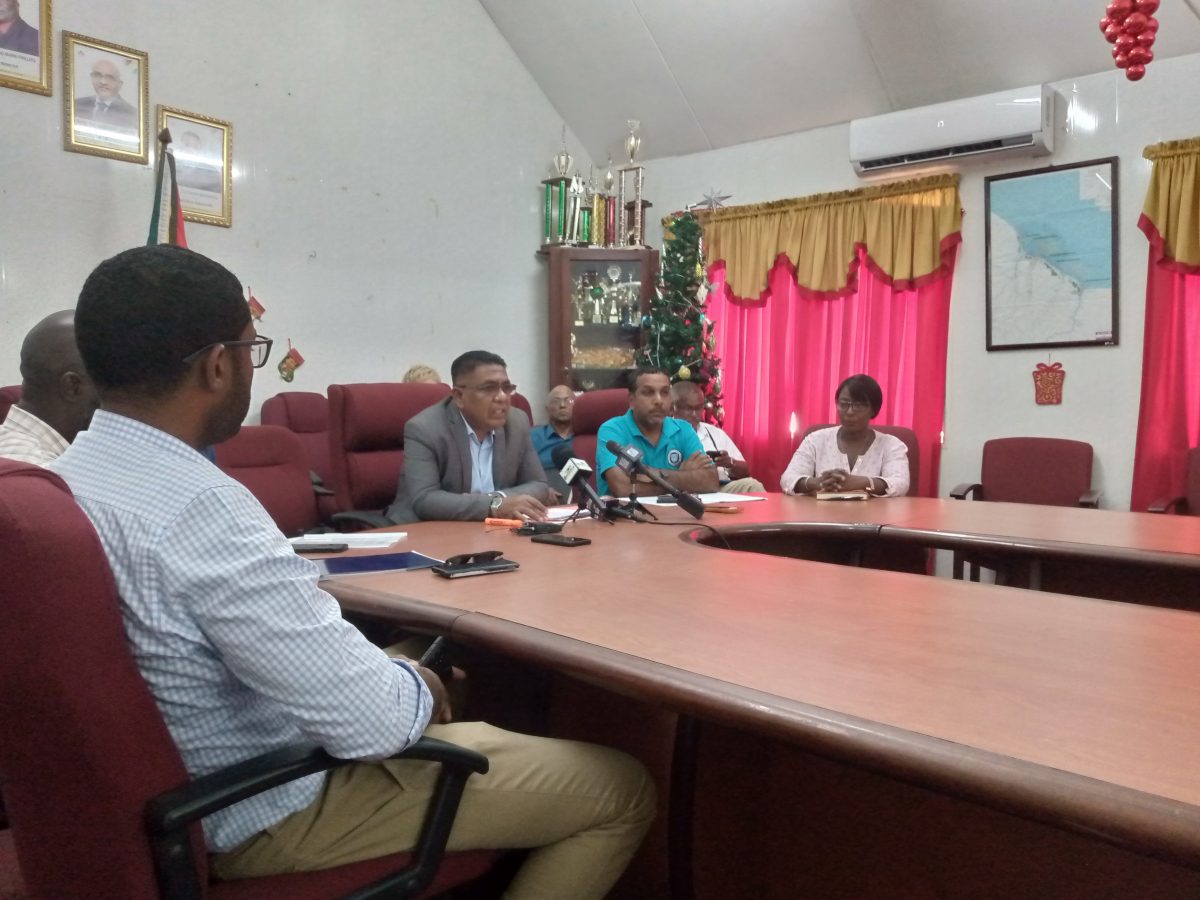Minister of Agriculture Zulfikar Mustapha yesterday assured that Guyana is on target in relation to the 25 per cent reduction of the regional food import bill by 2025, since the country is producing all of its livestock feed.
At a year-end press briefing at the Ministry of Agriculture where the overall performance of the agriculture sector for 2023 was discussed, the minister said that Guyana is reducing its dependency on imports, with approximately 10,000 acres of corn and soya bean being produced in 2023.
Mustapha highlighted that Guyana is diversifying its agriculture sector with the introduction of new crops to ensure food security.
“We have seen private investors sow 10,000 acres of corn and soya beans in 2023, with projections for 26,000 acres by the end of 2024 and 30,000 acres by the end of 2025. “This will take us to self-sufficiency in 2025 for us to produce all of our livestock feed for our country’s needs… And for us to be a net exporter in the Caribbean.”
The agriculture minister continued “So, that means this will be a big thing for us if we produce our own feed in Guyana, then, the cost for meat especially poultry and other meats will be reduced tremendously.”
He said that the government this year continued its unwavering support for corn and soya bean production with a wharf at Tacama, Upper Demerara/Upper Berbice, adding to the previous investment in a community road and a drying and storage facility.
“We have built 41 kilometres of road in the Tacama area there. We have built the silos, 9,000-tonne silos, which they are using to process the corn and soya. And we have seen production increasing over the years.
“With, two new investors in 2023 in Region Nine and another two new investors – Sheriff Group and Farmland Incorporated – in 2024. We are on our target for self-sufficiency to produce all the livestock feed and reducing our dependency on imports by 2025,” the Minister declared.
The agriculture minister recounted that on assuming office in August 2020, the government faced severe challenges as the country’s agri-food system was severely impacted due to the restrictions brought on by the COVID-19 pandemic.
He said that this crisis disrupted supply chains, leading to significant losses for farmers in the Caribbean, including Guyana.
“The collapse of tourism and food service sectors, along with social distancing measures, affected the harvest and sale of various agri-food products”, he noted.
He also spoke about the profound challenges that Guyana faced in mid-May 2021 when heavy rains unleashed major flooding.
The Minister noted that the 2021 flood predominantly impacted the agriculture sector, resulting in substantial losses and damage amounting to approximately $37 billion.
“80% of our agriculture sector was devastated due to these floods but we were able to bounce back despite the substantial losses and damages in cash crops among other commodities.”
On this note, he said that 2023 was a great year for the agriculture sector, despite the challenges in 2022 and 2021 which may have resulted in several setbacks.
Giving an update on ginger production, Mustapha announced that a total of 350 acres of this rhizome were cultivated between August 2022 and May 2023.
In 2023, ginger witnessed a 4% increase in production to 22,212 metric tonnes.
According to the minister, planting materials valued at approximately $30 million were distributed to farmers from regions One to Three.
For turmeric, the Minister informed that over 216 farmers benefitted from planting materials but could not say off hand the production rate of this spice.
He said that the ministry will continue to monitor the production of spices such as nutmeg, ginger, black pepper and turmeric.
Mustapha noted that currently these spices are cultivated in Region One, but cultivation will soon be decentralized.
Mustapha said that the government is ensuring that young people and women, especially single parents, are included in the agricultural diversification project as to date, revenue from sales of the roses amounts to $5.3 million while production for the year is 22,895 which represents 54.51% of the 42,000 roses imported annually.
Coconut
In 2023, approximately 40,000 coconut seedlings were produced, 1,274 additional acres came under cultivation, and 297 farmers from regions Two, Three, Four, Five, Six, and Ten, benefited from training in aspects of coconut production.
This has resulted in an approximately 10% increase in acreage in 2023 over 2020, with approximately 31,500 acres of coconut.
This year, the Ministry of Agriculture imported 26,000 high-yielding Brazilian Green Dwarf seed nuts to boost Guyana’s coconut production capacity.
This variety has the ability to produce approximately 75 ml of coconut water per nut. Some 216 farmers were contracted to cultivate this variety. As part of the national coconut decentralisation programme, coconut seedlings are currently being produced at 10 nurseries located in regions One, Two, Three, Four, Five, Six, and Nine.
Mustapha announced that coconut fibre and coco peat are now produced using coconut husk. A total of eight fibre machines will be in operation in different regions by the end of January 2024.
The minister detailed that the agriculture diversification project would also focus on the cultivation of citrus, spices, cocoa, coffee, onion, hemp, millet, wheat, and barley.
“These are some of the new crops that we have at an experimental stage that we will bring into our production stream in the coming years,” he informed, adding that two specialists have come from India to conduct studies to improve cultivation, in that specific area.





